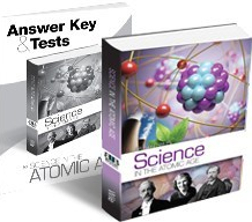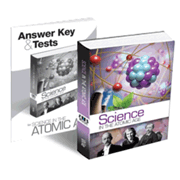Science in the Atomic Age is the final book in Dr. Jay Wile’s Science in History series, but it also works as a general science course for junior high students who have not used any of the previous courses. Science in the Atomic Age is an introduction to modern science that covers topics you will often find in other general science courses. It occasionally includes discussion about historical developments and key scientists, but the history plays a lesser role in this textbook than in the other History of Science courses.
The two essential components of this course are the hardcover textbook and the Answer Key & Tests book. The textbook has 16 chapters, each of which should take about two weeks to complete. (The first chapter is shorter than the others and will take less time.) Lab work directly relating to the lesson content is built into the lessons. Students perform an average of two experiments per week.
What It Covers
The course begins with an introductory chapter on the scientific method and how to conduct and record experiments. The next three chapters teach the basics of chemistry as students learn about atoms, elements, compounds, molecules, and chemical bonds. Chapter 5 begins to apply this knowledge of chemistry to living things with the study of topics such as carbohydrates, lipids, proteins, and DNA. Chapters 6 through 14 continue with biology topics as students study cells, plants, tissues, and the systems of the human body. In the final two chapters, students look at science in an integrated fashion as they learn about organisms, populations, and communities in Chapter 15 and ecosystems, biomes, and the biosphere in Chapter 16.
Science in the Atomic Age is written for Christian students with mentions of God as creator, discussion of the fine-tuning of the conditions on earth to support life, and a rejection of macro-evolution (changes of one species into another). However, faith-based comments are relatively rare and are presented briefly within the context of the lessons.
How It Works
Dr. Wile writes directly to the student in a casual style. He often uses rhetorical questions, as on page 32 where he discusses the work of Niels Bohr. Dr. Wile writes,
Now remember, Bohr wanted to explain the light that is emitted by excited atoms. Can you see how his theory does this? Think about the electron on the previous page. It is in a high-energy orbit. How can it get back to a lower energy orbit?
This sample is very typical of his style of writing throughout the textbook.
Within each chapter, colored boxes make it easy to spot different types of material. Pink boxes have statements that must be memorized. Within orange boxes, Dr. Wile works out examples of specific applications of concepts. Experiments are in blue boxes, and comprehension questions are in yellow boxes. (These are large boxed off sections of the text rather than sidebars.) In addition, vocabulary words and the names of people that students should be able to identify are in a bold font. These visual clues help students know what to do as they work through the textbook.
Even though the Science in the Atomic Age textbook is almost 500 pages in length, it is not overwhelming because it is printed with a relatively large font, includes illustrations and the colored text boxes, and devotes the last 46 pages to a glossary, an index, and the list of resources needed for experiments. Also, the textbook includes most of the other coursework: experiments, questions, and reviews.
The lesson material for some days has a larger amount of material to read, while on other days it has less to read but includes an experiment. All of the chapters except the first present the chapter’s lessons in seven sections that each conclude with a yellow box titled “Comprehension Check.” Students know they are done with the day’s lesson after they answer those questions. Answers to the comprehension questions are at the end of each chapter so that students can check themselves.
Following those answers is a one- or two-page chapter review. Using an open textbook, students will spend one or two days for each chapter defining terms and answering the questions in the review. Parents need to check those answers using the Answer Key & Tests book. They can then administer the chapter test that is also found in that book. The tests need to be photocopied from the book since there are often answer keys on the reverse of the test pages. There are no cumulative tests.
A dedicated page on the publisher’s website has other valuable resources that you might want to use. Supplementary videos and animations for each chapter are linked directly from this page. While the videos are optional, they provide much more visual input that is either directly or tangentially related to the lesson material.
The rest of the optional resources on the publisher’s website page are printable. These include a periodic table of the elements for quick reference, examples of how to write up lab work, and pages with the Comprehension Check and Review questions that provide enough space for students to write their answers. There is also a ready-to-print student notebook file that includes pages with the textbook questions plus blank pages to be used for a lab notebook. (Some resellers make this same notebook available as a spiral-bound book.) Students do not need the notebook, but it might make it easier to have questions and answers in the same place.
Lab Work
Dr. Wile believes that junior high students should learn how to document their experiments on lined or blank paper, so he does not provide pre-formatted pages with boxes and sections for recording lab work information. Instead, he gives a thorough explanation of how to document lab work in the first chapter. He includes an example in the first chapter and additional examples on the publisher’s website.
Students can complete experiments on their own. (Because of the integration of lessons, experiments, and experiment discussions, it's not really feasible to save experiments for group classes that meet only once a week.)
The experiments require household resources and supplies such as a stove, a hand-held hair drier, measuring spoons, Styrofoam™ cups, string, a nine-volt battery, modeling clay, ammonia, aluminum foil, food coloring, iodine, and unflavored gelatin. The list of resources is quite long for each chapter, so you should plan ahead to make sure you have what is needed.
Summary
Science in the Atomic Age is easy to follow and allows junior high students to work independently. Since it doesn’t require scientific equipment, it is an inexpensive option for a lab course. All of these features make it a good choice for those who want to prepare students well for high school science lab courses.













